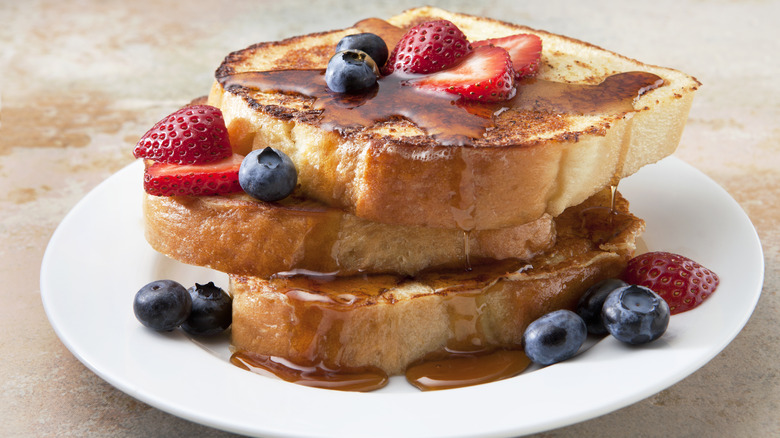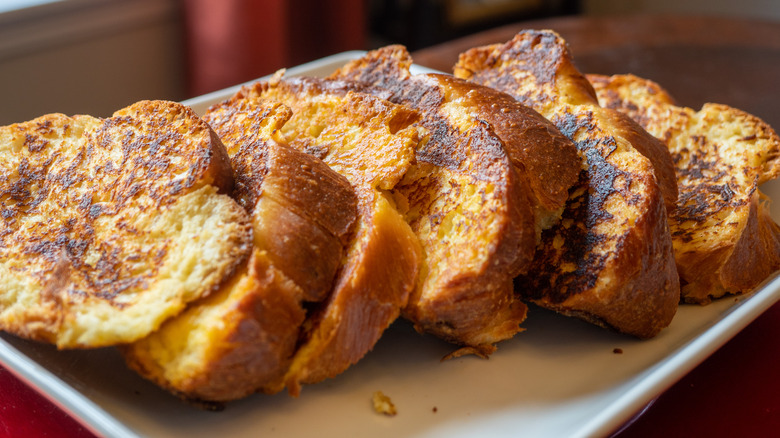The Reason French Toast Always Tastes So Much Better At A Restaurant
In the world of food feuds, few debates are as long standing as pancakes versus waffles. People have deep and passionate positions on this argument, but it's important to not forget that there is a third option in the sweet breakfast conversation. French toast is arguably one of the greatest breakfast foods in existence.
French toast is a fairly easy dish to make. Simply soak a slice of bread in an egg and milk mixture, often called a custard, then brown the bread on both sides in a skillet. However, there is no shortage of French toast hacks that can be employed to take this breakfast to the next level, and in fact, many of these tricks are already used at eateries. French toast always tastes better at a restaurant because the kitchen often uses better bread and cuts each slice thicker. Chefs also let the bread dry out, which allows these parched slices to soak up the custard for longer.
The best bread for fantastic French toast
A large part of the process behind making restaurant-quality French toast happens before cooking begins. For starters, standard, thin-sliced sandwich bread won't give a great end product. Restaurants often use unsliced loaves, so that each slice of toast can be cut to an appropriate thickness of between ½ to 1 inch. This thick cut makes the bread more capable of capturing custard.
Restaurants also change the breakfast game because they generally use better bread. French toast made with brioche bread ends up softer and sweeter than standard sandwich bread, and a dense baguette results in a gooier French toast. The similarly dense challah bread results in a comparable texture, but the bread is less sweet, which makes for a more savory breakfast.
Restaurant chefs often achieve the best French toast by using stale bread. In fact, French toast is a version of the French plate pain perdu, which translates to "lost bread," because it involves transforming bread that would typically be slated for a trip to the trash into a delicious dish. At home, if you don't have stale bread, you can toast the bread before it's soaked. Toasting bread so it's more absorptive is an obvious French toast hack that many home cooks may neglect.
More reasons restaurant French toast reigns supreme
A key component in a French toast recipe is the custard, which is made of eggs and milk. Restaurants will likely use whole-fat milk in this custard, which gives the French toast a rich consistency. A restaurant may even opt to add a small amount of cream to the custard, but this can oversaturate fresh bread. Restaurant French toast is generally a superior product because of time. Letting it soak in the custard for up to five minutes allows more delicious dairy to be absorbed. This step is where having stale bread is essential. Using soft fresh bread will take on too much custard and become a mushy mess.
Once the French toast is fried, instead of leaving it out to steam up and get soggy, restaurants will place the slices on a cooling rack atop a sheet pan and bake them on low heat. This keeps the French toast from taking on any extra moisture, and allows chefs to make larger batches of French toast at once.
Restaurant French toast also uses seasoned custard. Adding a pinch of cinnamon and a splash of vanilla extract are some of the more standard additions. For a sweeter French toast, you can add sugar, and to make it more savory, sprinkle in some salt.


